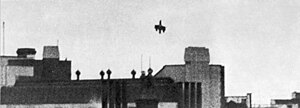Battle of Britain Day
| Battle of Britain | |||||||
|---|---|---|---|---|---|---|---|
| Part of the Western Front of the Second World War | |||||||
 Dornier Do 17 of Kampfgeschwader 76 falling on Victoria Station, Sunday 15 September 1940. |
|||||||
|
|||||||
| Belligerents | |||||||
|
|
|
||||||
| Commanders and leaders | |||||||
|
|
|
||||||
| Units involved | |||||||
|
|
|
||||||
| Strength | |||||||
| 50,000 observers 630 fighter aircraft |
1,120 aircraft (620 fighters and 500 bombers) | ||||||
| Casualties and losses | |||||||
| 29 aircraft destroyed ~ 21 damaged 14–16 killed 14 wounded 1 captured |
57–61 aircraft destroyed 20 severely damaged 63– 81 killed 63–65 captured 30–31 wounded 21 missing |
||||||
The Battle of Britain Day is the name given to the large-scale aerial battle that took place on 15 September 1940, during the Battle of Britain (German: Luftschlacht um England or Luftschlacht um Großbritannien).
In June 1940, the Wehrmacht had conquered most of Western Europe and Scandinavia. At that time, the only major power standing in the way of a German-dominated Europe was the British Empire and the Commonwealth. After having several peace offers rejected by the British, Adolf Hitler ordered the Luftwaffe to destroy the Royal Air Force (RAF) in order to gain air superiority or air supremacy as a prelude to launching Operation Sea Lion, an amphibious assault by the Wehrmacht (German armed forces) onto the British mainland.
In July 1940, the Luftwaffe started by closing the English Channel to merchant shipping. In August, Operation Adlerangriff (Eagle Attack) was launched against RAF airfields in southern England. By the first week of September, the Luftwaffe had not gained the results desired by Hitler. Frustrated, the Germans turned towards the strategic bombing of cities, an offensive which was aimed at British military and civil industries, but also civilian morale. The attacks began on 7 September 1940 and reached their daylight climax on 15 September.
On Sunday, 15 September 1940, the Luftwaffe launched its largest and most concentrated attack against London in the hope of drawing out the RAF into a battle of annihilation. Around 1,500 aircraft took part in the air battles which lasted until dusk. The action was the climax of the Battle of Britain.
RAF Fighter Command defeated the German raids. The Luftwaffe formations were dispersed by a large cloud base and failed to inflict severe damage on the city of London. In the aftermath of the raid, Hitler postponed Operation Sea Lion. Having been defeated in daylight, the Luftwaffe turned its attention to The Blitz night campaign which lasted until May 1941.
...
Wikipedia
